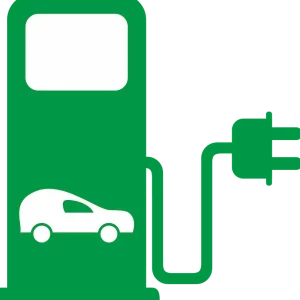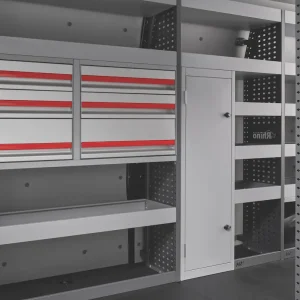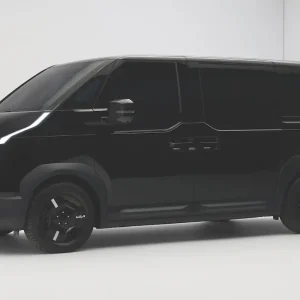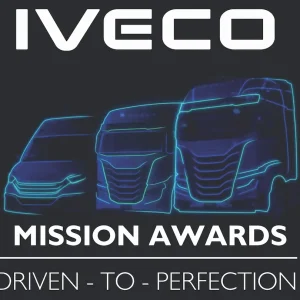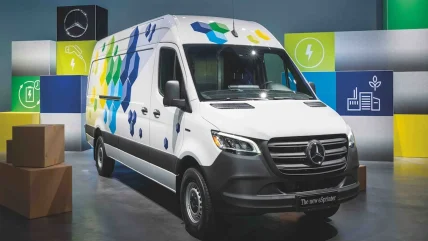
Mercedes-Benz has relaunched its eSprinter large electric van, increasing power and the van’s range. A new rear axle motor provides the power, while larger battery packs increase the range to up to 400km (249 miles).
The new electrically-driven rear axle improves the packaging of the electrical systems, saving weight and allowing Mercedes to produce more variants than previously offered. These will include chassis-cab models and several wheelbase lengths of panel van.
“With our first eSprinter we had a first to market approach,” explains Marcel Minter, head of business and product strategy Mercedes-Benz Vans.
“We were focused on the panel van and focused on the courier and parcel industries because that was an industry that wanted our [vehicles] to be quickly on the road, and to do CO2 free delivery with them. Now, with the chassis-cab we have much more possibilities to serve the customer. We have more than 50% of our vehicles getting fitted by upfitters so they have a broader range of use cases. We, as Mercedes-Benz Vans, can definitely address more customers than before and we are definitely going to do more business than today.”
Power for the eSprinter comes from a new permanent magnet synchronous motor producing either 100kW or 150kW. That’s a significant step up from the 85kW motor found in the previous eSprinter, which only produced 295Nm of torque compared to 400Nm for the new motor. The motor is said to weigh just 130kg, which along with the new, lighter batteries helps the eSprinter achieve a maximum payload of 1,575kg. Gross vehicle weights will be at 3.5 and 4.25t, while towing capacity has been set at up to 2.0t.
Three different battery sizes are available with 56kWh, 81kWh and 113kWh lithium iron phosphate packs that are now free from any cobalt or nickel. Previously the eSprinter was available with only two battery pack sizes, either 41kWh or 55kWh.
Charging rates have increased from the previous eSprinter’s 80kW maximum to 115kW. The Mercedes-Benz eSprinter has both AC and DC charging capabilities with a 10% to 80% recharge said to take just 28 minutes for the smaller 56kWh battery and 42 minutes for the biggest 113kWh battery pack.
Changes to the interior include the introduction of the MBUX infotainment system that has been adopted across its range of cars and vans. The system, with its 10in touchscreen and ‘Hey Mercedes’ voice recognition was omitted from the previous eSprinter to preserve range. That’s no longer the case.
The latest eSprinter gets the full MBUX system. It has also been updated with its own EV specific details. Real time data on battery charge levels and range will be given as part of a new line-up of “Electric Intelligence” systems. These will take into account the traffic conditions and typography of your route when predicting the range and can calculate the best possible charging strategy in order to get you to your destination. The new smart interactive range indicator links with the navigation and also allows you to plan for arriving at your destination with a certain level of charge.
Digitalisation will be a big growth area for Mercedes, where subscription or service packages will add additional revenue to the business. The introduction of MBUX is the first step towards integrating customers’ own systems with that of the van. The van.ea platform will take that concept a step further, and it is possible that even subscription services or outright purchasing options will be possible for future vans on a manner similar to the models being adopted by Tesla and BMW.

“With van.ea we are going to the next step in terms of connectivity, which gives us more opportunities in that direction. If you talk about Tesla and passenger car services, they’re more or less convenience services. If you want to have a heated seat, you want your autopilot, you can order it for one month or two months or six months or for forever. But switching on and switching off options that is more in the private sector. If you think of commercial options, of course, there are a lot of possibilities where you can say that you can make the life and business of our customers much more seamless than it is today. We’re already thinking in those directions, building an ecosystem for commercial customers. Providing services that makes their life easier and makes their business grow faster,” Minter explains.
While the future direction of the van.ea platform and its digital offering are yet to be revealed, Ralph Wagenknecht, of Mercedes-Benz Vans technology communications, says that future systems will likely build an ecosystem around the driver and the fleet, delivering valuable information to help improve efficiency. The concept was floated with the Mercedes Sustaineer van in 2021 whereby Android apps were integrated with MBUX to give fleet managers the special logistic and navigation software needed in segments like home delivery and parcel couriers.
“We had with Sustaineer the partner app developed, giving the driver and the fleet coordinator, a tool to be more efficient. There’s a connection between the [van] and the app. The driver gets feedback on how they were driving and performing during the day, and with specific situations where they could improve. They get, for example, YouTube videos, with some situations on how to improve driving to be more efficient to lose less energy. They also see ranking compared to the other guys in the fleet to get that gamification process running a little bit. These are cool things that could be in the future, maybe as digital software products you can sell on top,” he says.
While the new eSprinter won’t get any such abilities it is a stepping stone to what is possible. Using the example of a Formula One team making development changes for the next major set of rule changes, while also having to race in the current championship, Mercedes-Benz Vans is also trying to stay relevant in the current marketplace while pushing itself to develop the next generation of products.
“What we are planning with van.ea is pretty huge. The current spend on this platform is our way to do the transition from combustion to electric and it’s another huge step towards 2025. We are aware that this is not the one [size] fits all solution in terms of e-mobility, but we have to do it step by step and van.ea will be the next big step. It’s a little like the Formula One, we know there is a change coming to the car, and you start development way ahead but you have to do it alongside the current season. We had to develop and get an evolution of the current model and stay competitive. As well, we have to develop a complete new future without combustion engines,” says Minter.
The future of the Sprinter and eSprinter also means making a greater impact in the North American market, where Mercedes is still a bit-part player behind Ford, GM and Stellantis.
The new eSprinter will be a global electric LCV and will go on sale in the US and Canada ahead of its launch in Europe. Mercedes has sold more than 30,000 electric vans to date and has pledged to sell only electric and zero-emission vehicles from 2025 onwards. That means no new combustion engine models will be produced after this date.
While the next eSprinter is a significant improvement it’s how it will help Mercedes make that all important step towards zero-emission vehicles that really matters. As it still shares so many components with the combustion engine Sprinter, Minter says it will be easy for Mercedes to ramp up, or slow down, production according to customer demands. Therefore, not only is the new eSprinter a significant vehicle for customers wanting to do more in an electric van, it’s also important for Mercedes’ own road to zero plans.
Competition the key to unlock EV momentum
It feels like the electric van market is finally building some momentum with some new, exciting and very usable products that are fit for purpose for most people’s needs. I also think there’s an obvious reason for that. Competition.
While manufacturers have inevitably been working on their latest EVs for more than a minute or two, it’s been the arrival of the E-Transit that seems to have kick-started awareness of the sector and customers’ needs. There’s no doubting the eSprinter has, on paper, everything most zero-emission customers would need but would they have pushed for a 400km+ range without the need to better the competition? Of course, there’s every chance they’ve not been looking over their shoulders, but as my interview with a VW Amarok engineer outlined last month, not everyone is looking in close detail at what their rivals are doing.
Instead, I’d like to think that there’s a degree of one-upmanship and that it’s more than just the marketing folk that fixate on best-in-class abilities. So, what next? Well, for me the Stellantis medium vans have been the pick of the bunch for a while in that sector. But could the Volkswagen ID Buzz Cargo and incoming Ford E-Transit Custom spark another round of improvements. Let’s hope so.
George Barrow is the UK judge for the International Van of the Year, the prestigious prize awarded by leading European LCV journalists.

